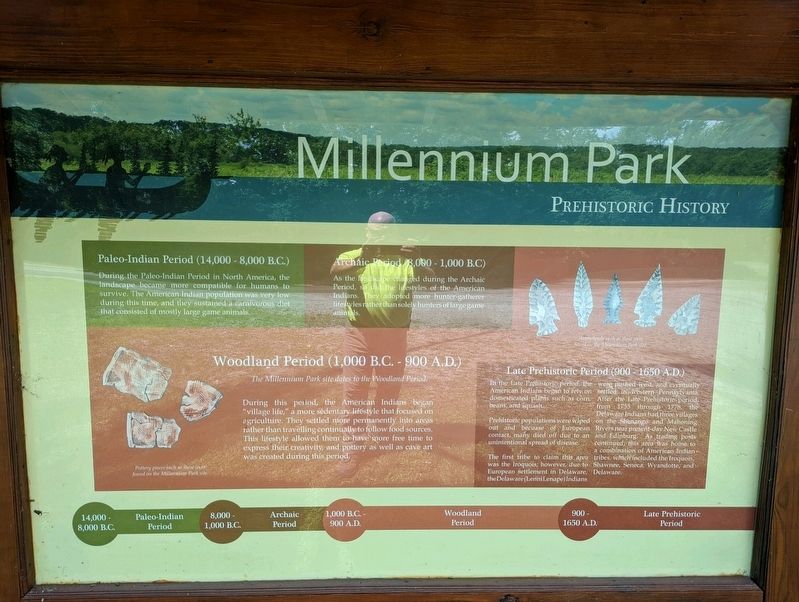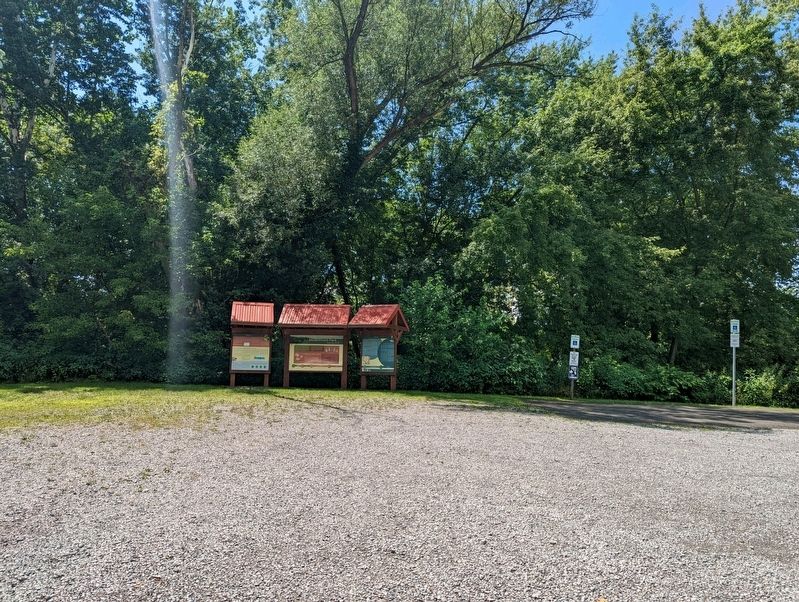Oakwood in Lawrence County, Pennsylvania — The American Northeast (Mid-Atlantic)
Millennium Park
Prehistoric History
During the Paleo-Indian Period in North America, the landscape became more compatible for humans to survive. The American Indian population was very low during this time, and they sustained a carnivorous diet that consisted of mostly large game animals.
Archaic Period (8,000-1,000 B.C.)
As the landscape changed during the Archaic Period, so did the lifestyles of the American Indians. They adopted more hunter-gatherer lifestyles rather than solely hunters of large game animals.
Woodland Period (1,000 B.C. - 900 A.D.)
The Millennium Park site dates to the Woodland Period
During this period, the American Indians began "village life,” a more sedentary lifestyle that focused on agriculture. They settled more permanently into areas rather than travelling continually to follow food sources. This lifestyle allowed them to have more free time to express their creativity, and pottery as well as cave art was created during this period.
Late Prehistoric Period (900-1650 A.D.)
In the Late Prehistoric period, the American Indians began to rely on domesticated plants such as corn, beans, and squash.
Prehistoric populations were wiped out and because of European contact, many died off due to an unintentional spread of disease.
The first tribe to claim this area was the Iroquois; however, due to European settlement in Delaware, the Delaware (LenniLenape) Indians were pushed west, and eventually settled in western Pennsylvania. After the Late Prehistoric period, from 1775 through 1778, the Delaware Indians had three villages on the Shenango and Mahoning Rivers near present-day New Castle and Edinburg. As trading posts continued, this area was home to a combination of American Indian tribes, which included the Iroquois, Shawnee, Seneca, Wyandotte, and Delaware.
Topics. This historical marker is listed in these topic lists: Native Americans • Parks & Recreational Areas. A significant historical year for this entry is 1775.
Location. 41° 2.257′ N, 80° 24.178′ W. Marker is in Oakwood, Pennsylvania, in Lawrence County. Marker can be reached from the intersection of Kings Chapel Road and Pulaski Road, on the right when traveling south. Touch for map. Marker is in this post office area: New Castle PA 16101, United States of America. Touch for directions.
Other nearby markers. At least 8 other markers are within 3 miles of this marker, measured as the crow flies. A different marker also named Millennium Park (here, next to this marker); a different marker also named Millennium Park (here, next to this marker); Harbor Creek (approx. ¼ mile away); The First M.E. Church in Lawrence County (approx. 1.1 miles away); Cross-Cut Canal (approx. 2.3 miles away); Ira D. Sankey (approx. 2.4 miles away); Edinburg World War II Memorial (approx. 2½ miles away); Kush-Kush-Kee (approx. 2.6 miles away). Touch for a list and map of all markers in Oakwood.
Credits. This page was last revised on August 2, 2022. It was originally submitted on August 2, 2022, by Mike Wintermantel of Pittsburgh, Pennsylvania. This page has been viewed 98 times since then and 19 times this year. Photos: 1, 2. submitted on August 2, 2022, by Mike Wintermantel of Pittsburgh, Pennsylvania.

